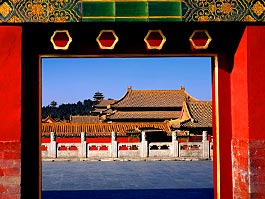
The biggest and most complete ancient building complex is the former Imperial Palace (also known as the Forbidden City) in Beijing. It was imperial palace of both the Ming and Qing dynasties. It was first completed in 1420 and covers an area of 720,000 square meters.
The Forbidden City, now called the Palace Museum, is located in the center of Beijing. Starting in 1420, the Forbidden City was the home to 24 Chinese emperors during the Ming and Qing dynasties (1368-1911). Now, it has developed into the Palace Museum, which displays art treasures of the past dynasties and is the richest treasury of cultures and arts in China. Lofty and magnificent, the Forbidden City is acclaimed as one of the world five great palaces, ranking with Palace of Versailles in France, Buckingham Palace in Britain, White House in the United States and Kremlin in Russia, and was listed by UNESCO as a World Cultural Heritage Site in 1987.
Extending 750 meters east-west and 960 meters north-south, The Forbidden City covers 720,000 square meters, and is the largest palatial complex in the world and the most complete ancient architectural group extant in China. It has 9,999 buildings, and is called the Ocean of Palaces. No matter in terms of plain layout, three-dimensional effect or magnificent appearance, the complex is really an unparalleled masterpiece in the world. A central axis runs through the whole palace and the axis happens to be on the central axis of Beijing City. The Forbidden City is divided into southern and northern parts by the axis: The former served as the emperor`s work area and the latter as his living quarters. The main structures are arranged along the central axis, and the buildings on both sides of it are symmetrical.
The main structures in the work area that cannot be missed are the Taihe Dian (the Hall of Supreme Harmony), Zhonghe Dian (the Hall of Central Harmony) and Baohe Dian (the Hall of Preserved Harmony). All the three main halls are built on an eight-meter-high platform covering a total area of about 85,000 square meters. The Taihe Dian is the largest and most imposing hall. It is 60.1 meters wide, 33.33 meters deep and 35.05 meters high. Here the most important ceremonies of the feudal dynasties were held, such as the emperor`s enthronement, his marriage and his conferring of titles and issuing orders on expeditions. On these occasions, thousands of people chanted "long life, long life, and long, long life" to his majesty, and hundreds of musical instruments and bells and drums sounded in unison. Behind the Taihe Dian is the Zhonghe Dian, where the emperor used to rest and receive officials before attending major ceremonies. The northernmost structure is the Baohe Dian, in which the emperor threw banquets and interviewed successful candidates for imperial examinations.
The living quarters include the Qianqing, Jiaotai and Kunning halls and the six lesser halls on the east and west sides, which together are called "three main halls and six lesser halls", where the emperor and his concubines lived. North of the living quarters is a small but exquisite imperial garden. In the Ming Dynasty (1368-1644) and at the beginning of the Qing Dynasty (1644-1911), all the emperors lived in the Qianqing Gong (the Palace of Heavenly Purity), while empresses lived in the Kunning Gong (the Palace of Earthly Tranquility). The Jiaotai Dian (the Hall of Union) was a place for the activities of the empresses. But in the middle and late periods of the Qing Dynasty, the emperors and empresses all moved to the six lesser halls on the west side. The most famous is the Yangxin Dian (the Hall of Mind Cultivation). It became the place where most Qing emperors, starting from Emperor Yongzheng, lived and handled state affairs. It is also the place where Empress Dowager Cixi attended to state affairs behind the scenes for as long as 40 years.
The whole complex is tightly guarded by two defense lines. One is the moat, which is 52 meters wide and six meters deep, surrounding the city wall; and the other is the city wall, which is 3,400 meters long, 10 meters high and 8.62 meters wide at the bottom. There are four gates: Wumen Gate to the south, Shenwu Gate to the north, Donghua Gate to the east and Xihua Gate to the west. On the four corners stand four turret towers, each with three layers of eaves and 72 ridges. They are masterpieces of the ancient architectural art.
Some halls in the Palace Museum have developed into the Hall of Historical Arts, the Hall of Jewelry, the Hall of Watches and Clocks, the Hall of Paintings, the Hall of Potteries, the Hall of Toys and so on. The museum has a collection of 1,052,653 pieces of ancient art treasures, accounting for one sixth of the total cultural relics in China. It is the museum with the richest collection of cultural relics in China, and also a world-famous museum of ancient cultural arts. Many cultural relics preserved in it are unique in the world.


